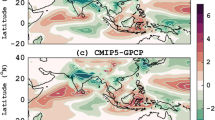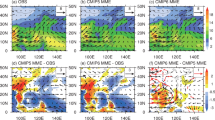Abstract
The capability of the National Centers for Environmental Prediction climate forecast system version 2 (CFSv2) in simulating the Indian summer monsoon (ISM) is evaluated in the context of the global monsoon in the Indo-Pacific domain and its variability. Although the CFSv2 captures the ISM spatial structure qualitatively, it demonstrates a severe dry bias over the Indian subcontinent. The weaker model monsoon may be related to an excessive surface convergence over the equatorial Indian Ocean, which reduces the moisture transport toward the Indian subcontinent. The excessively low equatorial pressure is in turn a part of a tropical-wise bias with the largest errors in the central and eastern equatorial Pacific associated with the cold sea surface temperature bias and an overly strong inter-tropical convergence zone. In this sense, the model bias in the tropical Pacific influences those in the Indian Ocean-ISM region substantially. The leading mode of the June–September averaged CFSv2 rainfall anomalies covering the ISM and its adjacent oceanic regions is qualitatively similar to that of the observations, characterized by a spatial pattern of strong anomalies over either side of the Indian peninsula as well as center of opposite sign over Myanmar. However, the model fails to reproduce the northward expansion of rainfall anomalies from Myanmar, leading to opposite anomalies over northeast India and Himalayas region. A substantial amount of the anomalous fluctuation is attributed to the El Niño and the Southern Oscillation (ENSO), although the model variability depends more strongly on ENSO. The active regional influences in the observations may contribute to its baroclinic vertical structure of the geopotential height anomalies in the ISM region, compared with the predominantly barotropic one in CFSv2. Model ENSO deficiencies also affects its ISM simulation significantly.














Similar content being viewed by others
References
Achuthavarier D, Krishnamurthy V, Kirtman BP, Huang B (2012) Role of Indian Ocean in the ENSO–Indian summer monsoon teleconnection in the NCEP climate forecast system. J Clim 25:2490–2508
Adler RF, Huffman GJ, Chang A, Ferraro R, Xie PP, Janowiak J, Rudolf B, Schneider U, Curtis S, Bolvin D, Gruber A, Susskind J, Arkin P, Nelkin E (2003) The version-2 Global Precipitation Climatology Project (GPCP) monthly precipitation analysis (1979–present). J Hydrometeorol 4:1147–1167
Ashok K, Guan Z, Yamagata T (2001) Impact of the Indian Ocean dipole on the relationship between the Indian monsoon rainfall and ENSO. Geophys Res Lett 28:4499–4502
Charney JG, Shukla J (1981) Predictability of monsoons. In: Lighthill J, Pearce RP (eds) Monsoon dynamics. Cambridge University Press, Cambridge, pp 99–109
Chaudhari HS, Pokhrel S, Saha SK, Dhakate A, Yadav RK, Salunke K, Mahapatra S, Sabeerali CT, Rao SA (2013) Model biases in long coupled runs of NCEP CFS in the context of Indian summer monsoon. Int J Climatol 33:1057–1069
Findlater J (1969) A major low-level air current near the Indian Ocean during the northern summer. Q J R Meteorol Soc 95:362–380
Goswami BN, Xavier PK (2005) Dynamics of internal interannual variability of the Indian summer monsoon in a GCM. Geophys Res Lett 110:D24104. doi:10.1029/2005JD006042
Guilyardi E, Gualdi S, Slingo J, Navarra A, Delecluse P, Cole J, Madec G, Roberts M, Latif M, Terray L (2004) Representing El Niño in coupled ocean–atmosphere GCMs: the dominant role of the atmospheric component. J Clim 17:4623–4629
Huang B, Kinter JL III (2002) Interannual variability in the tropical Indian Ocean. J Geophys Res 107(C11):3199. doi:10.1029/2001JC001278
Huang B, Shukla J (2007a) Mechanisms for the interannual variability in the tropical Indian Ocean—part I: the role of remote forcing from the tropical Pacific. J Clim 20:2917–2936
Huang B, Shukla J (2007b) Mechanisms for the interannual variability in the tropical Indian Ocean—part II: regional processes. J Clim 20:2937–2960
Huang B, Zhu J, Marx L, Wu X, Kumar A, Hu ZZ, Balmaseda MA, Zhang S, Lu J, Schneider EK, Kinter JL (2015) Climate drift of AMOC, North Atlantic salinity and arctic sea ice in CFSv2 decadal predictions. Clim Dyn 44:559–583. doi:10.1007/s00382-014-2395-y
Jiang X, Yang S, Li Y, Kumar A, Liu X, Zuo Z, Jha B (2013) Seasonal-to-interannual prediction of the Asian summer monsoon in the NCEP climate forecast system version 2. J Clim 26:3708–3727
Kalnay E et al (1996) The NCEP/NCAR 40-year reanalysis project. Bull Am Meteorol Soc 77:437–471
Kim HJ, Wang B, Ding Q (2008) The global monsoon variability simulated by CMIP3 coupled climate models. J Clim 21:5271–5294. doi:10.1175/2008JCLI2041.1
Kinter JL III, Miyakoda K, Yang S (2002) Recent change in the connection from the Asian Monsoon to ENSO. J Clim 15:1203–1215
Kirtman BP, Shukla J (2000) Influence of the Indian summer Monsoon on ENSO. Q J R Meteorol Soc 126:213–239
Krishna KK, Rajagopalan B, Cane M (1999) On the weakening relationship between the Indian monsoon and ENSO. Science 284:2156–2159
Krishnamurti TN, Bhalme HN (1976) Oscillations of a monsoon system—part I: observational aspects. J Atmos Sci 33:1937–1954
Lau NC, Nath MJ (2000) Impact of ENSO on the variability of the Asian-Australian monsoons as simulated in GCM experiments. J Clim 13:4287–4307
Levine RC, Turner AG (2012) Dependence of Indian monsoon rainfall on moisture fluxes across the Arabian Sea and the impact of coupled model sea surface temperature biases. Clim Dyn 38:2167–2190. doi:10.1007/s00382-011-1096-z
Levine RC, Turner AG, Marathayil D, Martin GM (2013) The role of northern Arabian Sea surface temperature biases in CMIP5 model simulations and future projections of Indian summer monsoon rainfall. Clim Dyn 41:155–172. doi:10.1007/s00382-012-1656-x
Lidnzen RS, Nigam S (1987) On the role of sea surface temperature gradients in forcing low-level winds and convergence in the tropics. J Atmos Sci 44:2418–2436
LinHo, Wang B (2002) The time–space structure of the Asian-Pacific monsoon: a fast annual cycle view. J Clim 15:2001–2019
Mishra V, Li H (2014) The seasonal predictability of the Asian summer monsoon in a two-tiered forecast system. Clim Dyn. doi:10.1007/s00382-013-1838-1
North R, Bell T, Cahalan R, Moeng F (1982) Sampling errors in the estimation of empirical orthogonal functions. Mon Weather Rev 110:699–706
Pokhrel S, Chaudhari HS, Saha SK et al (2012) ENSO, IOD and Indian summer monsoon in NCEP climate forecast system. Clim Dyn 39:2143–2165
Rasmusson EM, Carpenter TH (1983) The relationship between eastern equatorial Pacific sea surface temperature and rainfall over India and Sri Lanka. Mon Weather Rev 111:517–528
Reynolds RW, Smith TM (1995) A high-resolution global sea surface temperature climatology. J Clim 7:1571–1583
Saha K (1970) Zonal anomaly of sea surface temperature in equatorial Indian Ocean and its possible effect upon monsoon circulation. Tellus 22:403–409
Saha S et al (2010) The NCEP climate forecast system reanalysis. Bull Am Meteorol Soc 91:1015–1057
Saha SK, Pokhrel S, Chaudhari HS, Dhakate A, Shewale S, Sabeerali CT, Salunke K, Hazra A, Mahapatra S, Rao AS (2014a) Improved simulation of Indian summer monsoon in latest NCEP climate forecast system free run. Int J Climatol 34:1628–1641
Saha S, Moorthi S, Wu X, Wang J, Nadiga S, Tripp P, Behringer D, Hou Y-T, Chuang H, Iredell M, Ek M, Meng J, Yang R, Malaquías Mendez P, van den Dool H, Zhang Q, Wang W, Chen M, Emily B (2014b) The NCEP climate forecast system version 2. J Clim 27:2185–2208
Saji NH, Goswami BN, Vinayachandran PN, Yamagata T (1999) A dipole mode in the tropical Indian Ocean. Nature 401:360–363
Shin C-S, Huang B (2015) Slow and fast annual cycles of the Asian summer monsoon in the NCEP CFSv2. Clim Dyn (under review)
Shukla J (1975) Effect of Arabian sea-surface temperature anomaly on Indian summer monsoon: a numerical experiment with the GFDL mode. J Atmos Sci 32:503–511
Shukla J (1987) Interannual variability of monsoons. In: Fein JS, Stephens PI (eds) Monsoons. Wiley, New York
Shukla RP (2014) The dominant intraseasonal mode of intraseasonal South Asian summer monsoon. J Geophys Res Atmos. doi:10.1002/2013JD020335
Shukla RP, Huang B (2015) Interannual variability of the Indian summer monsoon associated with the air–sea feedback in the northern Indian Ocean. Clim Dyn. doi:10.1007/s00382-015-2687-x
Shukla RP, Kinter JL III (2014) Simulation of the Asian Monsoon using a regionally-coupled global climate mode. Clim Dyn. doi:10.1007/s00382-014-2188-3
Shukla J, Paolin DA (1983) The Southern oscillation and long range forecasting of the summer monsoon rainfall over India. Mon Weather Rev 11:1830–1837
Shukla RP, Zhu J (2014) Simulations of boreal summer intraseasonal oscillations with CFSv2 over India and western Pacific: role of air–sea coupling. Atmos Ocean. doi:10.1080/07055900.2014.939575
Shukla RP, Tripathi KC, Pandey AC, Das IML (2011) Prediction of Indian Summer monsoon rainfall using Niño indices: a neural network approach. Atmos Res 102(1):99–109. doi:10.1016/j.atmosres.2011.06.013
Wallace JM, Rasmusson EM, Mitchell TP, Kousky VE, Sarachik ES, vonStorch H (1998) On the structure and evolution of ENSO-related climate variability in the tropical Pacific: lessons from TOGA. J Geophys Res 103(C7):14241–14259. doi:10.1029/97JC02905
Wang B, Ding Q (2006) Changes in global monsoon precipitation over the past 56 years. Geophys Res Lett 33:L06711. doi:10.1029/2005GL025347
Wang B, Kang IS, Lee J-Y (2004) Ensemble simulations of Asian-Australian monsoon variability by 11 AGCMs. J Clim 17:803–818
Wang B, Ding Q, Fu X, Kang I-S, Shukla J, Doblas-Reyes F (2005) Fundamental challenge in simulation and prediction of summer monsoon rainfall. Geophys Res Lett 32:L15711. doi:10.1029/2005GL022734
Webster PJ, Yang S (1992) Monsoon and ENSO: selectively interactive systems. Q J R Meteorol Soc 118:877–926
Webster PJ, Magana VO, Palmer TN, Shukla J, Tomas RA, Yanai M, Yasunari T (1998) Monsoons: processes, predictability and the prospectsfor prediction. J Geophys Res 103:451–510
Wu R, Kirtman BP (2003) On the impacts of the Indian summer monsoon on ENSO in a coupled GCM. Q J R Meteorol Soc 129B:3439–3468
Wu R, Kirtman BP (2005) Roles of Indian and Pacific Ocean air–sea coupling in tropical atmospheric variability. Clim Dyn 25:155–170
Wu R, Kirtman BP (2007) Regimes of seasonal air–sea interaction and implications for performance of forced simulations. Clim Dyn 29:393–410
Wu G, Zhang Y (1998) Tibetan plateau forcing and the timing of the monsoon onset over South Asia and the South China Sea. Mon Weather Rev 126:913–927
Xie P, Arkin PA (1997) Analysis of global monthly precipitation using gauge observations, satellite estimates and numerical predictions. J Clim 9:840–858
Yang S, Zhang Z, Kousky VE et al (2008) Simulations and seasonal prediction of the Asian summer monsoon in the NCEP climate forecast system. J Clim 21:3755–3775
Yulaeva E, Wallace JM (1994) The signature of ENSO in global temperature and precipitation fields derived from the microwave sounding unit. J Clim 7:1719–1736
Zhu J, Shukla J (2013) The role of air–sea coupling in seasonal prediction of Asia-Pacific summer monsoon rainfall. J Clim 26:5689–5697
Zuo Z, Yang S, Hu Z-Z, Zhang R, Wang W, Huang B, Wang F (2013) Predictable patterns and predictive skills of monsoon precipitation in Northern Hemisphere summer in NCEP CFSv2 reforecasts. Clim Dyn 40:3071–3088. doi:10.1007/s00382-013-1772-2
Acknowledgments
Funding for this study was provided by Grants from the National Science Foundation (ATM-0830068, 0947837 and 1338427), the National Oceanic and Atmospheric Administration (NA09OAR4310058 and NA14OAR4310160), and the National Aeronautics and Space Administration (NNX09AN50G, NNX09AI84G and NNX14AM19G). The authors thank Prof. Jagadish Shukla, Prof. James L. Kinter III and national monsoon mission (NMM) group at COLA/GMU for their helpful comments. We also thank Dr. M. A. Balmaseda from ECMWF for providing their ocean initial conditions and L. Marx’s help in the experiment setup. Computing resources provided by the Extreme Science and Engineering Discovery Environment (XSEDE) division are also gratefully acknowledged.
Author information
Authors and Affiliations
Corresponding author
Ethics declarations
Conflict of interest
The authors declare that they have no conflict of interest.
Rights and permissions
About this article
Cite this article
Shukla, R.P., Huang, B. Mean state and interannual variability of the Indian summer monsoon simulation by NCEP CFSv2. Clim Dyn 46, 3845–3864 (2016). https://doi.org/10.1007/s00382-015-2808-6
Received:
Accepted:
Published:
Issue Date:
DOI: https://doi.org/10.1007/s00382-015-2808-6




